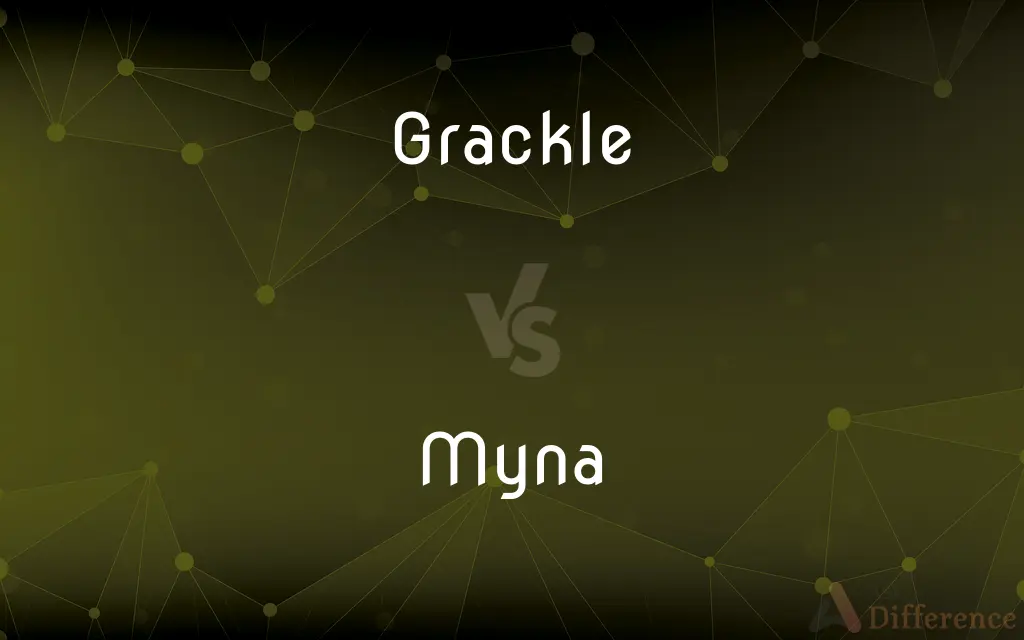Grackle vs. Myna — What's the Difference?
Edited by Tayyaba Rehman — By Maham Liaqat — Updated on March 31, 2024
Grackles are New World birds known for their iridescent plumage, while mynas, native to Asia, are renowned for their vocal abilities and adaptation to urban environments.

Difference Between Grackle and Myna
Table of Contents
ADVERTISEMENT
Key Differences
Grackles, part of the Icteridae family, are often found across North and South America, displaying a range of colors and known for their glossy, iridescent feathers. Mynas, belonging to the starling family (Sturnidae), are primarily native to Asia, Africa, and parts of Australia, and are celebrated for their impressive mimicry skills, including the ability to replicate human speech.
While grackles are adaptable and can thrive in various environments, from agricultural lands to urban areas, they are often seen as pests due to their large numbers and the noise they generate. Mynas, particularly the Common and Hill mynas, have successfully adapted to urban environments, where they are both admired for their intelligence and criticized for being invasive species that displace native birds.
Grackles have a diverse diet, consuming everything from insects to grains, which enables them to thrive in a wide range of habitats. Mynas, on the other hand, are omnivorous with a diet that includes insects, fruits, and human scraps, contributing to their success in urban areas.
The social behavior of grackles includes forming large flocks that can dominate food sources and roosting sites, which is a common reason for their nuisance status in many areas. Mynas are also social birds, but their ability to live alongside humans has led to a unique relationship with people, from being kept as pets for their speaking ability to being considered pests.
Comparison Chart
Family
Icteridae
Sturnidae
ADVERTISEMENT
Native Range
North and South America
Asia, Africa, Australia
Known For
Iridescent plumage
Mimicry of sounds
Environment
Varied, including urban
Primarily urban and suburban
Diet
Omnivorous, diverse
Omnivorous, includes human scraps
Social Behavior
Forms large flocks
Social, adapts well to human presence
Impact
Considered pests in many areas
Valued for vocal ability, but can be invasive
Compare with Definitions
Grackle
Found across the Americas, grackles adapt well to both wild and urban settings.
Grackles can often be seen foraging in parking lots.
Myna
A bird belonging to the starling family, Sturnidae, noted for its ability to mimic sounds.
The myna bird copied the ringtone perfectly.
Grackle
A bird of the family Icteridae, known for its glossy, iridescent body.
The common grackle shimmered in the sunlight.
Myna
They have a versatile diet, which aids their adaptation to various environments.
The myna was seen eating leftovers at the café.
Grackle
They play an ecological role in seed dispersal and pest control.
Grackles in the garden help reduce insect pests.
Myna
Mynas can become invasive, displacing native bird species.
Invasive mynas are threatening the local bird populations.
Grackle
They have a varied diet, including insects, grains, and small animals.
Grackles at the feeder scare away smaller birds.
Myna
Native to Asia but has spread globally, often found in urban areas.
Mynas have become common sights in city parks.
Grackle
Known to form large, noisy flocks that can be a nuisance.
A flock of grackles took over the backyard trees at dusk.
Myna
Valued as pets for their social nature and vocal skills.
My pet myna can say several phrases clearly.
Grackle
Grackle is the common name of any of 11 passerine birds (10 extant and one extinct) native to North and South America. They belong to various genera in the icterid family.
Myna
The myna (; also spelled mynah) is a bird of the starling family (Sturnidae). This is a group of passerine birds which are native to southern Asia, especially India, Pakistan and Bangladesh.
Grackle
Any of several blackbirds of the family Icteridae found throughout the Americas, especially those of the genus Quiscalus, having iridescent blackish plumage.
Myna
Any of various starlings found in South and Southeast Asia and on some islands of the South Pacific, most of which are bluish-black or dark brown with a yellow bill. Certain species, especially the hill myna, are known for mimicry of human speech.
Grackle
Any of several Asian mynas of the genus Gracula.
Myna
One of the South and East Asian birds of the starling family Sturnidae.
Grackle
Any of several American blackbirds of the genus Quiscalus, and related genera, having iridescent plumage.
Myna
Any one of numerous species of Asiatic starlings of the genera Acridotheres, Sturnopastor, Sturnia, Gracula, and allied genera. In habits they resemble the European starlings, and like them are often caged and taught to talk. See Hill myna, under Hill, and Mino bird.
Grackle
(formerly) Any of several Asian myna birds of the genus Gracula.
Myna
Tropical Asian starlings
Grackle
One of several American blackbirds, of the family Icteridæ; as, the rusty grackle (Scolecophagus Carolinus); the boat-tailed grackle (see Boat-tail); the purple grackle (Quiscalus quiscula, or Q. versicolor). See Crow blackbird, under Crow.
Grackle
Glossy black Asiatic starling often taught to mimic speech
Grackle
Long-tailed American blackbird having iridescent black plumage
Common Curiosities
What distinguishes a grackle from a myna?
Grackles are known for their iridescent plumage and are native to the Americas, while mynas are celebrated for their vocal mimicry and are primarily found in Asia.
Can grackles mimic human speech like mynas?
Grackles do not typically mimic human speech, a trait for which mynas are particularly renowned.
Do grackles have any positive ecological impact?
Yes, grackles play a role in seed dispersal and pest control, contributing positively to their ecosystems.
What role do grackles play in agriculture?
Grackles can be both beneficial by controlling pests and problematic by damaging crops.
Are grackles considered invasive species?
While grackles can be considered pests due to their numbers and behavior, they are usually not labeled invasive in their native range, unlike some myna species.
How do grackles and mynas affect biodiversity?
While grackles can dominate food sources and habitats, invasive myna species pose a greater threat to biodiversity by displacing native species.
Why are mynas often seen as pests?
Mynas can be pests due to their adaptability to urban environments, where they compete with native species and become overabundant.
Why are mynas able to adapt so well to urban environments?
Mynas are highly adaptable, omnivorous, and intelligent, traits that help them thrive in urban settings.
Are there efforts to control invasive myna populations?
Yes, there are various control measures in place in areas where mynas have become invasive, including habitat management and trapping.
What measures can help mitigate the impact of invasive mynas?
Habitat management, public awareness, and controlling breeding populations are effective measures.
What makes mynas good pets?
Mynas are sociable and can mimic human speech, making them entertaining and engaging pets.
What are the conservation statuses of grackles and mynas?
While many grackle species are not currently at risk, some myna species, especially those invasive outside their native range, are subject to control measures to protect biodiversity.
What is the native range of grackles?
Grackles are native to North and South America, thriving in a variety of habitats within these continents.
Can mynas affect the populations of other urban wildlife?
Yes, mynas can compete aggressively for nesting sites and food, impacting native urban wildlife populations.
How can one differentiate between a grackle and a myna?
Differences include physical characteristics like plumage, native ranges, and behaviors, particularly vocal mimicry in mynas.
Share Your Discovery

Previous Comparison
Assembly vs. Congress
Next Comparison
Dab vs. DobAuthor Spotlight
Written by
Maham LiaqatEdited by
Tayyaba RehmanTayyaba Rehman is a distinguished writer, currently serving as a primary contributor to askdifference.com. As a researcher in semantics and etymology, Tayyaba's passion for the complexity of languages and their distinctions has found a perfect home on the platform. Tayyaba delves into the intricacies of language, distinguishing between commonly confused words and phrases, thereby providing clarity for readers worldwide.














































